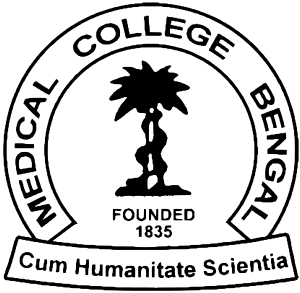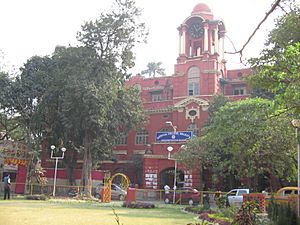Medical College and Hospital, Kolkata facts for kids
 |
|
| Motto | Latin: Cum Humanitate Scientia |
|---|---|
|
Motto in English
|
Humanity and Science |
| Type | Public |
| Established | 28 January 1835 |
| Founder | Lord William Bentinck |
|
Academic affiliations
|
|
| Principal | Prof. Dr. Raghunath Mishra, M.D. (Community Medicine) |
|
Academic staff
|
258 |
| Students | 2,370 |
| Undergraduates | 1,245 |
| Postgraduates | 600 |
| 525 | |
| Location |
88 College Street, Kolkata 700001
22°34′25″N 88°21′43″E / 22.5736°N 88.3619°E |
| Campus | Urban 26 acres (0.11 km2) |
Calcutta Medical College, officially Medical College and Hospital, Kolkata, is a public medical school and hospital in Kolkata, West Bengal, India. It is the oldest existing hospital in Asia. The institute was established on 28 January 1835 by Lord William Bentinck during British Raj as Medical College, Bengal.
It is the second oldest medical college to teach Western medicine in Asia after Ecole de Médicine de Pondichéry and the first institute to teach in English language. The hospital associated with the college is the largest hospital in West Bengal. The college offers MBBS degree after five and a half years of medical training.
Ranking
| University and college rankings | |
|---|---|
| Medical – India | |
| NIRF (2021) | 32 |
| Outlook India (2019) | 19 |
The college was ranked 19th among medical colleges in India in 2019 by Outlook India.
For the first time Medical College, Kolkata ranked 32nd among Medical Institution by National Institutional Ranking Framework (NIRF) in 2021.
Politics
Student politics is rooted in tradition, with many students participating in the Indian freedom struggle. Anti-British movements were implemented with the programmes of Bengal Provincial Students' Federation (BPSF), the Bengal branch of All India Students' Federation. Student politics was initially focused on the independence of India. In 1947, Sree Dhiraranjan Sen, a student of the college, died during a Vietnam Day police firing. The Vietnam Students’ Association passed a resolution in its Hanoi session in memory of Sen in March 1947.
Student politics were highly influenced by the partition of Bengal and communal riots during and after the partition of India. Between 1946 and 1952, the college's doctors stood for communal harmony and worked hard in the refugee colonies. During 1952, ex-students of the college, among them Bidhan Chandra Roy who became the second Chief Minister of West Bengal, established the Students' Health Home for the welfare of students.
From the 1950s to the 1970s, the college became a centre of leftist and far-left politics. Student politics was highly influenced by the Naxalbari uprising in the early 1970s.
Notable alumni
- Pasupati Bose, Indian physician and professor of anatomy
- Upendranath Brahmachari, discoverer of the treatment of Kala-azar
- Aroup Chatterjee, British Indian atheist physician, author of Mother Teresa: The Untold Story
- Nirmal Kumar Dutta, Indian pharmacologist, medical academic and the director of Haffkine Institute
- Lionel Emmett, member of the Indian field hockey team in the 1936 Summer Olympics
- Dipyaman Ganguly, N-Bios laureate
- Kadambini Ganguly, the first certified South Asian female physician qualified for Western medical practice
- Madhusudan Gupta, the first Indian trained in Western medicine to dissect a human corpse.
- David Hare, founder of Hare School
- K. B. Hedgewar, also known as Doctorji, was the founding Sarsanghachalak of the Rashtriya Swayamsevak Sangh.
- Vikram Marwah – Padma Shri awardee, conferred Dr. B. C. Roy Award by the President of India.
- Kamaleshwar Mukherjee, filmmaker
- M. D. Ray, surgical oncologist and author
- Balai Chand Mukhopadhyay
- N. C. Paul, first physician to examine yoga
- Bidhan Chandra Roy, noted physician and the 2nd Chief Minister of West Bengal
- Ram Baran Yadav, first president of Nepal




